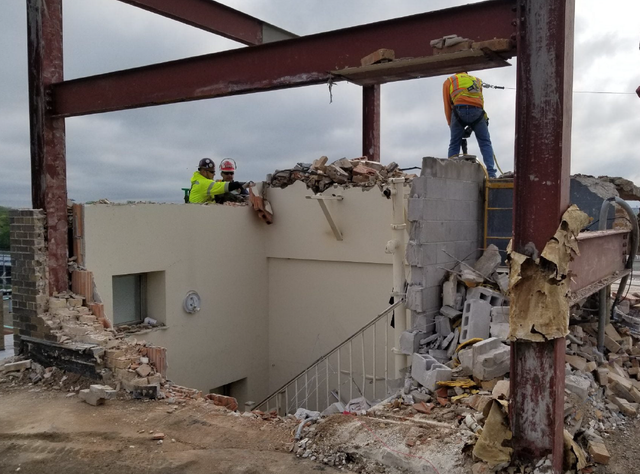Specialist Tips for Handling Dust Throughout Interior Demolition
Specialist Tips for Handling Dust Throughout Interior Demolition
Blog Article
The Ultimate Guide to Inside Demolition Techniques and Equipments
Within the realm of indoor remodellings, the art of demolition is a pivotal stage that requires accuracy, ability, and the right set of devices. Whether you are a skilled professional or a Do it yourself fanatic, recognizing the complexities of indoor demolition techniques can make all the distinction in attaining a successful task result.
Crucial Indoor Demolition Tools
When taking on interior demolition projects, having the suitable devices is crucial for effectiveness and security. One of the most important tools for interior demolition is the demolition hammer. This heavy-duty tool is made to damage through tough products like drywall, concrete, and tile.
One more important tool is a reciprocating saw, which is ideal for puncturing a variety of materials such as timber, steel, and plastic. Its capability to make accurate cuts in tight rooms makes it excellent for demolition work. Additionally, an utility knife is needed for cutting products like rug, plastic floor covering, and insulation. Its sharp blade makes sure precise and tidy cuts, promoting the removal of unwanted materials. Overall, having these vital interior demolition devices will substantially enhance the efficiency and safety and security of any kind of demolition project.

Security Precautions During Demolition

Additionally, all workers involved in the demolition process should get ample training on the correct handling of devices and equipment to lessen mishaps. By adhering to these security precautions, indoor demolition projects can be lugged out successfully while focusing on the wellness of all individuals entailed.
Strategies for Eliminating Wall Surfaces
Executing proper safety and security preventative measures during interior demolition jobs is crucial for creating a protected working atmosphere, and one vital facet of such projects involves understanding techniques for removing wall surfaces. One commonly used approach is manual demolition, which requires using standard hand tools such as sledgehammers, crowbars, and utility knives to carefully take apart the wall piece by piece. This strategy permits better control over the demolition process, specifically in fragile locations where precision is essential.
For larger, extra complicated walls, mechanical demolition might be necessary. This involves making use of heavy equipment like excavators or excavators to knock down walls successfully. Nonetheless, it is important to make certain that the architectural stability of the building is not endangered throughout mechanical demolition.
One more strategy for eliminating wall surfaces is deconstruction, where the wall is taken apart in a manner that maintains reusable materials. This lasting method is eco-friendly and can additionally assist reduce disposal expenses. Whichever strategy is employed, it is vital to comply with proper security procedures and take into consideration the structural ramifications of wall elimination to guarantee an effective interior demolition project.
Removing Floor Covering Like a Pro
Successfully getting rid of flooring throughout indoor demolition needs the proper tools and strategies to ensure a smooth and successful process. The initial step in eliminating floor covering is to clear the area of any furnishings or barriers. Next, identify the kind of flooring to establish the proper elimination method. For informative post hardwood or laminate flooring, beginning by removing the baseboards and after that use a floor covering scraper to raise and detach the slabs. Carpet elimination includes cutting the carpet into manageable sections and rolling it up for disposal. For ceramic tile or vinyl floor covering, a chisel or flooring scraper can be used to pry up the sheets or floor tiles. It's necessary to use protective gear such as gloves, goggles, and a mask to avoid injuries and direct exposure to dust and debris. Additionally, having a dumpster or assigned disposal location prepared for the eliminated floor covering products is critical for keeping a clean job environment. By adhering to these strategies and using the right devices, eliminating flooring like a pro can be accomplished effectively and efficiently.
Proper Waste Disposal Techniques
After successfully removing floor covering making use of the appropriate devices and methods, the following vital step in the indoor demolition procedure is implementing correct garbage disposal approaches. Correct waste disposal is essential for maintaining a risk-free and tidy workplace during and after demolition. Among the main approaches for waste disposal is segregating products into various categories such as recyclable, harmful, and click to investigate basic waste. This segregation guarantees that products are taken care of appropriately and sensibly.

Professionals should comply with local policies relating to garbage disposal to avoid charges and penalties. Making use of professional waste administration services can enhance the disposal procedure and make sure conformity with ecological standards. By implementing proper waste disposal methods, interior demolition projects can be completed efficiently and sustainably.
Conclusion
Finally, interior demolition requires making use of essential tools and strict safety precautions to ensure a safe and effective procedure. Strategies for getting you could check here rid of wall surfaces and floor covering need to be done very carefully and effectively to prevent any damage or accidents. Proper waste disposal techniques are also important to preserve a well organized and tidy workspace. By following these guidelines, interior demolition can be completed properly and with marginal threats.
One of the most vital tools for interior demolition is the demolition hammer (interior demolition). On the whole, having these essential indoor demolition tools will significantly enhance the performance and security of any demolition task
Effectively removing floor covering during indoor demolition calls for the appropriate tools and methods to ensure a smooth and effective procedure.After efficiently removing floor covering using the suitable devices and techniques, the following important action in the indoor demolition process is applying proper waste disposal techniques.In final thought, interior demolition needs the usage of vital devices and rigorous security preventative measures to ensure a risk-free and effective procedure.
Report this page